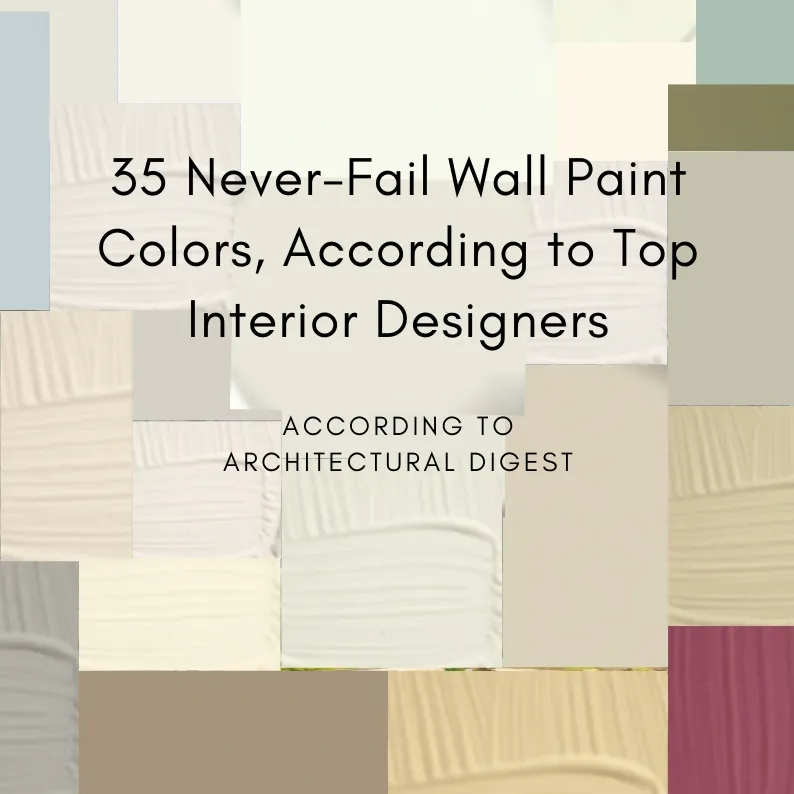The selections of 35 Never-Fail Wall Paint Colors, which range from neutral to pigment-rich, are wonderfully versatile
With the seemingly endless variety of color swatches, asking AD100 designers to pick just one go-to wall paint seems like a presumptuous request. And for some, it was. “It depends on the local light,” Ilse Crawford explains. Fellow honoree Miranda Brooks of Miranda Brooks Landscape Design concurs: “Different climates take different colors—I can’t commit!”
Thankfully, other designers—some 35 of them—entertained the idea. A select few designers nominated rich, contemplative colors, but the final palette of never-fail pigments is largely neutral, ranging from white to brown to gray (and all the beiges and greiges that come between them). Find the designer-approved wall paint colors below.
Whites
Crisp, classic white paint is a no-brainer for its versatility—its ability to amplify light throughout a space is simply a bonus. As designer Markham Roberts puts it, “There’s nothing like a coat of white paint!” Designer Nicole Hollis, who is also well-versed in statement-making paint choices, ranks Farrow & Ball’s All White No. 2005 (pictured above, #1) among her tried-and-true colors. Drake/Anderson and Nate Berkus Associates opt for Benjamin Moore’s Chantilly Lace OC-65 (#2) and Alabaster OC-129 (#3), respectively, while Ashe Leandro adores the manufacturer’s Super White OC-152 (#5). For ETC.etera, Benjamin Moore’s Decorator’s White OC-149 (#4) stands by its name. “It’s such a cliché, but it works,” says firm cofounder Jake Rodehuth-Harrison.
Off-Whites
A majority of the AD100 designers surveyed chose a relaxed white, like that of lightweight linen or organic fossils. “You can’t go wrong with it,” says Beata Heuman, who names Farrow & Ball’s Strong White No. 2001 (pictured above, #4). Design studios 5 Solidos and Dan Fink Studio also favor the manufacturer, selecting Wevet No. 273 (#1) and Ammonite No. 274 (#2) as respective top picks. As did Gachot Studios, who dubs Farrow & Ball’s Wimborne White No. 239 (#3) the firm’s “forever go-to.”
Others endorsing the ecru-like hue include Julie Hillman Design, which recommends Cloud White OC-130 (#5) by Benjamin Moore. Amy Lau Design prefers the paint maker’s slightly deeper Seapearl OC-19 (#6), while Elliott Barnes Interiors turns to Argile Peinture’s Mousse Blanche V44 (#7), a nuanced, earthy hue. Waldo’s Designs, Leyden Lewis Design Studio, and Virginia Tupker Interiors spec from Benjamin Moore’s off-white palette selecting, in turn, China White OC-141 (#8), Cotton Balls OC-122 (#9), and Soft Chamois OC-13 (#10).
Creams
A pale, buttery tint adds warmth while remaining neutral. Joy Moyler Interiors often specs the pearly Mayonnaise OC-85 (pictured above, #1) by Benjamin Moore, while the tried-and-true palette at Corey Damen Jenkins & Associates begins with PPG’s Garlic Clove 18-09 (#4). Robert Couturier turns to Pointing No. 2003 (#2), while Studio Volpe selects Skimming Stone No. 241 (#3), both from Farrow & Ball.
Beiges
Tiptoeing into a richer mineral palette, the beige color family promises pigments that are memorable without being overpowering. Billy Cotton and R.P. Miller lean into wheaty tones, with the former backing Bone No. 15 (pictured above, #1) and the latter choosing String No. 8 (#2) from Farrow & Ball. Others champion the timelessness of refined, shroom-y colorways. Grant Beige HC-83 (#3), Alexandria Beige HC-77 (#4), and Manchester Tan HC-81 (#5)—all from Benjamin Moore—are preferred by Michael S. Smith, Mark Hampton LLC, and Pierce & Ward, respectively.
Greiges
One of the greatest perks of a greige pigment is its versatility within various interior styles—as lucid in a cozy country house as in an urbane modern loft. Victoria Hagan Interiors recommends Fog Mist OC-31 (pictured above, #1), a hazy pigment from Benjamin Moore, when in doubt. Architecture and design firms Sawyer | Berson and Charlap Hyman & Herrero advise a more metallic-inspired route, advocating for the paint maker’s Balboa Mist OC-27 (#2) and Nimbus 1465 (#3).
Grays
Cooler gray tones are alluringly complex yet soft and airy. Fox-Nahem Associates appreciates the dichotomy in Benjamin Moore’s Silver Gray 2131-60 (pictured above, #1). For design studios Why and S.R. Gambrel, the color family’s asphalt tones are favored for their adaptability. They recommend Lamp Room Gray No. 88 (#2) by Farrow & Ball and Paper White OC-55 (#3) by Benjamin Moore, respectively
Cool Palette
For those wanting to look beyond neutrals, designers recommend earthy tones that will play nicely with a variety of materials, such as reclaimed wood, polished stone, and rattan. Jan Showers & Associates is partial to Benjamin Moore’s Wythe Blue HC-143 (pictured above, #1), while Martin Brudnizki Design Studio picks Tea Green (#2) by Edward Bulmer Natural Paints from green’s vast palette, and Reath Design is drawn to Spanish Olive 1509 (#3) by Benjamin Moore.
Warm Palette
Romantic, rosy hues capture both daytime and evening light. The trick? Finding a pigment with a just-right balance of warm and cool tones. Ken Fulk counts Farrow & Ball’s Setting Plaster No. 213 (pictured above, #1) among his never-fail options, while Studio Giancarlo Valle trusts the manufacturer’s Radicchio No. 96 (#2).
By Mel Studach
January 15, 2021
Article pulled from Architectural Digest
For more information on which colors would be best for your space, give us a call or send us a message!



